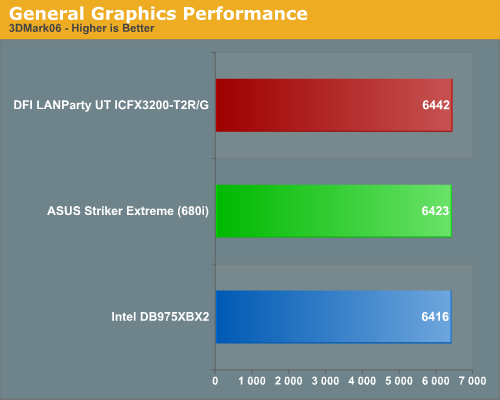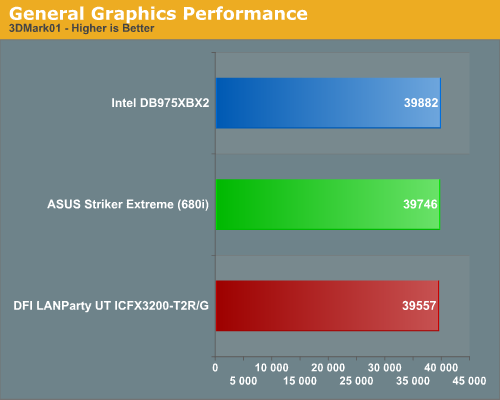DFI LANParty UT ICFX3200-T2R: ATI's, err, AMD's RD600 finally arrives
by Gary Key on December 16, 2006 7:00 PM EST- Posted in
- Motherboards
General Application Performance
The performance of the board was very good and usually slotted itself in between the Intel D975XBX2 and ASUS Striker Extreme in our benchmark scores. While not a great SuperPi or Folding@Home number crunching motherboard, we did find the application performance to be very good and consistently near the 975X based Intel motherboard, with 3D performance normally leading both boards as our game benchmarks will reveal shortly. Throughout testing we generally found the AMD RD600 chipset to be slightly faster than the NVIDIA 680i when operating at like settings. We changed the tCAS, tRCD, tRP, tRAS, and the command timing rates (RD600/680i) for each board but left the sub-timings at auto settings for our tests. Once we optimized the sub-timings on both boards, the results improved about two percent when compared to the 975X.
However, neither chipset could match the stock performance of the Intel 975X board. In our Nero Recode test we consistently found the performance of the 680i to be lacking due to disk access issues. The conversion process would consistently slow down while the disk was being accessed. The quality of the video conversion was not affected but it appears under heavy CPU usage that disk performance suffers at this time. NVIDIA is aware of this issue and is working on a driver update currently. We will provide a full suite of benchmarks and include additional chipsets in our upcoming in-depth review.
Synthetic Graphics Performance
The 3DMark series of benchmarks developed and provided by Futuremark are among the most widely used tools for benchmark reporting and comparisons. Although the benchmarks are very useful for providing apple to apple comparisons across a broad array of GPU and CPU configurations they are not a substitute for actual application and gaming benchmarks. In this sense we consider the 3DMark benchmarks to be purely synthetic in nature but still very valuable for providing consistent measurements of performance.


In our 3DMark06 test, each platform score is so close that there is no real winner here. In the more memory and CPU sensitive 3DMark2001 benchmark we see the Intel 975X board pulling away from the 680i and RD600 boards due to its superior memory bandwidth at stock settings. Although our reported Sandra memory bandwidth scores along with Memtest86 testing consistently show the RD600 performing better than the 680i, our 3DMark2001 benchmark is not showing this advantage. While our first thought was to look at lower than expected video throughput performance our gaming scores indicate otherwise. In additional testing with higher memory speeds or optimized memory sub-timings we did find the 3DMark01 scores improved consistently, leading us to believe this board just does not perform as well as the others in this particular benchmark.
General System Performance
The PCMark05 benchmark developed and provided by Futuremark was designed for determining overall system performance for the typical home computing user. This tool provides both system and component level benchmarking results utilizing subsets of real world applications or programs. This benchmark is useful for providing comparative results across a broad array of Graphics subsystems, CPU, Hard Disk, and Memory configurations along with multithreading results. In this sense we consider the PCMark benchmark to be both synthetic and real world in nature while providing consistency in our benchmark results.

The ASUS 680i based board has a strong showing in this benchmark and finishes ahead of the other two offerings. All three boards actually score very close together and after reviewing the individual test results we noticed the 680i had very competitive disk benchmarks which is unusual considering our Nero Recode tests. The disk performance of the SB600 was slightly better than the ICH7R on the Intel board and both were about two percent faster on average than the 680i. However, the 680i performs best on the graphics subsystem tests with the RD600/975X splitting the three multitasking tests.
 |
| Click to enlarge |
The performance of the board was very good and usually slotted itself in between the Intel D975XBX2 and ASUS Striker Extreme in our benchmark scores. While not a great SuperPi or Folding@Home number crunching motherboard, we did find the application performance to be very good and consistently near the 975X based Intel motherboard, with 3D performance normally leading both boards as our game benchmarks will reveal shortly. Throughout testing we generally found the AMD RD600 chipset to be slightly faster than the NVIDIA 680i when operating at like settings. We changed the tCAS, tRCD, tRP, tRAS, and the command timing rates (RD600/680i) for each board but left the sub-timings at auto settings for our tests. Once we optimized the sub-timings on both boards, the results improved about two percent when compared to the 975X.
However, neither chipset could match the stock performance of the Intel 975X board. In our Nero Recode test we consistently found the performance of the 680i to be lacking due to disk access issues. The conversion process would consistently slow down while the disk was being accessed. The quality of the video conversion was not affected but it appears under heavy CPU usage that disk performance suffers at this time. NVIDIA is aware of this issue and is working on a driver update currently. We will provide a full suite of benchmarks and include additional chipsets in our upcoming in-depth review.
Synthetic Graphics Performance
The 3DMark series of benchmarks developed and provided by Futuremark are among the most widely used tools for benchmark reporting and comparisons. Although the benchmarks are very useful for providing apple to apple comparisons across a broad array of GPU and CPU configurations they are not a substitute for actual application and gaming benchmarks. In this sense we consider the 3DMark benchmarks to be purely synthetic in nature but still very valuable for providing consistent measurements of performance.


In our 3DMark06 test, each platform score is so close that there is no real winner here. In the more memory and CPU sensitive 3DMark2001 benchmark we see the Intel 975X board pulling away from the 680i and RD600 boards due to its superior memory bandwidth at stock settings. Although our reported Sandra memory bandwidth scores along with Memtest86 testing consistently show the RD600 performing better than the 680i, our 3DMark2001 benchmark is not showing this advantage. While our first thought was to look at lower than expected video throughput performance our gaming scores indicate otherwise. In additional testing with higher memory speeds or optimized memory sub-timings we did find the 3DMark01 scores improved consistently, leading us to believe this board just does not perform as well as the others in this particular benchmark.
General System Performance
The PCMark05 benchmark developed and provided by Futuremark was designed for determining overall system performance for the typical home computing user. This tool provides both system and component level benchmarking results utilizing subsets of real world applications or programs. This benchmark is useful for providing comparative results across a broad array of Graphics subsystems, CPU, Hard Disk, and Memory configurations along with multithreading results. In this sense we consider the PCMark benchmark to be both synthetic and real world in nature while providing consistency in our benchmark results.

The ASUS 680i based board has a strong showing in this benchmark and finishes ahead of the other two offerings. All three boards actually score very close together and after reviewing the individual test results we noticed the 680i had very competitive disk benchmarks which is unusual considering our Nero Recode tests. The disk performance of the SB600 was slightly better than the ICH7R on the Intel board and both were about two percent faster on average than the 680i. However, the 680i performs best on the graphics subsystem tests with the RD600/975X splitting the three multitasking tests.










42 Comments
View All Comments
lplatypus - Sunday, December 17, 2006 - link
umm isn't that why the article was called a "quick performance preview"?yyrkoon - Sunday, December 17, 2006 - link
Perhaps you should look again.
lplatypus - Sunday, December 17, 2006 - link
I was referring to the description of the article on the anandtech.com front page:Goty - Sunday, December 17, 2006 - link
Perhaps you should read the article again and realize that they're going to do a few follow-up articles. There's also the fact that the last section is called "Initial Thoughts".Avalon - Saturday, December 16, 2006 - link
511FSB max for $229 doesn't sound that impressive to me. I can get a $110 Biostar 965PT to do that. Hopefully a newer BIOS will allow much higher FSB clocks. Nevertheless, I don't think this board will be for me anymore.Goty - Sunday, December 17, 2006 - link
That is possibly the most shortsighted comment I've heard in the past week. You aren't buying this motherboard just for the stated maximum FSB, you're buying it for the amazing feature set, you're buying it for the memory clock that's not coupled to the FSP, you buy it for the fact that it performs about the same as the other high-end chipsets (not the midrange P965), and you buy it for the incredible tweaking possibilities. The Biostar board is that cheap because it has NONE of these things going for it.Avalon - Sunday, December 17, 2006 - link
You are full of crap. Just because a board has more features than another doesn't make it the best out there. The networking features I won't use, and a decoupled memory clock doesn't seem to do squat for REAL WORLD performance. At the end of the day, it's all about the CPU clocks, and this board AT THIS TIME (note I said I'd be looking forward to future BIOS releases, please try reading my posts before exploding into DFI ass kiss mode) does not seem to offer any significant advantages over other good boards.So again, I ask why I should spend $229 for this board when I can get similar CPU overclocking performance for $110-$115? Sorry, but memory and FSB tweaks that account for a few percent in benchmarks are not going to sway me from the $100+ savings. Not worth it IMO. This board will not be for me, but for the benchmark enthusiast.
Goty - Sunday, December 17, 2006 - link
Oh, and another thing, I'm interested in finding out how you can say the decoupling the memory clock from the FSB seems to provide no performance gain when benchmarking of different memory speeds at a constant FSB hasn't even been done yet.Goty - Sunday, December 17, 2006 - link
Not once did I say that this board was the best out there, I said it had the best feature set. You're telling me the board isn't worth the money because you can buy a cheaper board that overclocks similarly. I say that there are people out there who genuinely want the features of this chipset (me being one of them) and people who will use them. Just because you won't use the features doesn't mean that the board is not worth the money, it's just not worth it to you.Avalon - Monday, December 18, 2006 - link
Funny, I don't remember telling YOU that YOUR opinion should be the board isn't worth the money. I said it isn't worth it to ME. Way to restate what I said.